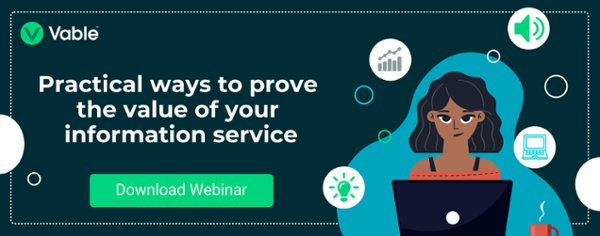Share this
5 awesome ways to improve ROI on your subscriptions
July 13, 2020

How do you know if you’re investing in the right resources? Our organisations are currently facing some difficult financial challenges, so all budgets are under review. One area that library and information people will be looking at carefully is online premium or subscription content. This important paid-for content provides your end-users with information and intelligence that free resources don’t cover.
However, assessing its value requires more than just counting downloads. We have the statistics, but we also need to look at its impact and how it is used to see the full picture. I’ve put together some thoughts about how we can improve the ROI of paid content.
Create an external content strategy
First, sketch out your content strategy. Strategic planning of any kind is not difficult but it requires an investment in time and staffing resources. However, it’s a worthwhile exercise because it enables your service to become more efficient. You need to know what the organisation is looking to achieve and how the information service can be a part of that.
Think about the scope of your external content strategy. What is the reason you are collecting information about your resources? Is it budgetary? Is it part of the disaster recovery / business continuity plan? To improve your current awareness? To help the company make better-educated decisions? Is it for competitor analysis or to build business development?
Once you have fleshed out your goals and your team is happy with the result, it’s time to put your plan into action and achieve your objectives.
Justify your current sources
Subscribing to several premium external content sources is costly. In some industries, there are a limited number from which to choose and each publisher offers a different emphasis. Choosing which ones are needed is no simple task, and it may come down to basic budget considerations. Ask yourself - and your users:
- What is the rationale behind using a particular source?
- Who is it for, and are they effectively using it?
- What are people used to?
- Is there any overlap with other sources?
- How fast do they publish material about recent events? How reliable is the source?
- Can you successfully track the usage rate of each subscription?
Estimating the return on investment for each premium content source can be challenging, but it’s important to understand the value that each subscription brings to your readers. The right content aggregation tool can help you track the usage of every subscription and source accurately.
Identify and assess new sources of information
Once you have a clearer vision of the subscription material available to your users, you might find gaps in your information provision. You might find areas of duplication, or one department which is over-provided for; drowning in information isn’t a good strategy. The goal is to select one or two relevant sources that cover exactly what you need.
During your investigations, you might have discovered that your organisation is looking to build up an area of new speciality. It’s much easier to plan for and anticipate needs when you know what your organisation is planning. Building a road map of requirements will help you prioritise which sources should be picked and what they will add to your organisation’s shared knowledge.
You also need to find out what information will be relevant in this new area. It should be directed by the end-user’s needs. Are they looking for detailed insight, or a “broad brush” overview? An encyclopaedic text, or specialist articles? News, government sources or commentary? Do you need to investigate foreign sources?
Tips for contract negotiation
Negotiations take time, and rushing through the process won’t serve anyone well; unfavourable terms, overpaying for services, poor customer relations, etc. To successfully negotiate a contract, you have to tackle it step by step, going through the easier relationship-building aspects first, and then working your way through the more difficult issues.
Allow yourself to take some time in your calendar to review all your premium subscriptions and to renegotiate the terms according to the usage your company has. Remember that certain times of year are more favourable times to negotiate, for example, salespeople might be able to grant discounts before the end of their fiscal year.
Most vendors and large publishers provide room for negotiation, and if you have prepared well, there is the opportunity for some mutually beneficial renewals. For example, multi-year deals mean security for the vendor, and you can save time and money over the next few years. If they are an innovative solution provider, ask if you can beta-test something - you’re at the cutting edge, and they get valuable feedback.
Whatever your library management strengths and weaknesses, get comfortable with negotiating skills. Ask for internal assistance, if necessary. You might have access to a procurement team, or have an ally in the finance or marketing team. There are also courses to learn more about negotiating - get signed up and it might pay dividends.
Using a content aggregation solution: Getting the right resources to the right people
Your content has to reach the right audience. Creating an efficient content distribution strategy isn’t easy. Content overload coupled with a bad distribution process is usually the recipe for a disaster that can paralyse an entire system. Identifying bottlenecks in the process can help you find solutions.
Look at every current awareness newsletter, forwarded email, chance encounter, intranet page, research request, induction, or departmental meeting as an opportunity to advertise your content delivery services. You can connect in many ways:
- An email sign-off with an inviting Call-To-Action (CTA) might send people to a library services webpage so you can sell them new and existing services using your content.
- Create innovative videos explaining why readers and end-users need the latest library and information update, research service, or training session. Demonstrate that you can save them time and money!
- Ask for a 5 minute slot (you might get 30 mins!) at the next annual/quarterly/half year organisation meeting to tell people how you have contributed to the ongoing success of the organisation.
- If you are doing your own horizon scanning, you can anticipate shifting trends and inform people about what’s going on before they even ask you.
- Collaborate with the business development team, management team, IT, and the wider firm so you can work on joint initiatives and get involved at all levels.
Whatever you are doing, get noticed! People are used to seeing slick and well-presented material online so don’t let your readers down.There are many easy-to-use multimedia apps available, so you can create and enhance professional communications and reports. With the right systems in place, Vable can report that information people see the immediate benefit, with one information and research team telling us,
We can respond faster and deliver more, highly curated, relevant updates, customised to people’s needs [and a] professional, fresh design has elevated the team’s output.
Having a clear content strategy will enable a flying start. There are many ways to get your content in front of the right audience so choose wisely and the right content management or current awareness aggregation platform will solve many issues at once. Enjoy reporting an increased or higher return on your information and content investment.
Automate your processes ● Curate your resources ● Deliver actionable content
Share this
- December 2025 (1)
- November 2025 (2)
- October 2025 (3)
- September 2025 (2)
- August 2025 (2)
- July 2025 (4)
- June 2025 (3)
- May 2025 (2)
- April 2025 (1)
- March 2025 (1)
- October 2024 (1)
- July 2024 (1)
- June 2024 (2)
- May 2024 (2)
- April 2024 (3)
- March 2024 (3)
- February 2024 (4)
- January 2024 (2)
- December 2023 (1)
- November 2023 (2)
- October 2023 (2)
- September 2023 (1)
- August 2023 (3)
- July 2023 (5)
- June 2023 (2)
- May 2023 (2)
- April 2023 (4)
- March 2023 (1)
- February 2023 (1)
- January 2023 (2)
- November 2022 (2)
- September 2022 (2)
- August 2022 (2)
- July 2022 (1)
- June 2022 (1)
- May 2022 (2)
- April 2022 (3)
- March 2022 (1)
- February 2022 (2)
- December 2021 (2)
- November 2021 (2)
- October 2021 (2)
- September 2021 (2)
- August 2021 (2)
- July 2021 (2)
- June 2021 (2)
- May 2021 (1)
- April 2021 (2)
- March 2021 (1)
- February 2021 (3)
- January 2021 (2)
- November 2020 (3)
- October 2020 (1)
- August 2020 (2)
- July 2020 (4)
- June 2020 (1)
- May 2020 (1)
- April 2020 (2)
- March 2020 (2)
- February 2020 (3)
- January 2020 (1)
- December 2019 (2)
- November 2019 (1)
- October 2019 (1)
- September 2019 (1)
- August 2019 (3)
- July 2019 (3)
- June 2019 (3)
- May 2019 (2)
- April 2019 (1)
- March 2019 (2)
- February 2019 (3)
- January 2019 (3)
- December 2018 (1)
- November 2018 (2)
- October 2018 (2)
- September 2018 (1)
- August 2018 (2)
- July 2018 (1)
- June 2018 (2)
- May 2018 (3)
- April 2018 (3)
- March 2018 (1)
- February 2018 (3)
- January 2018 (1)
- November 2017 (1)
- October 2017 (1)
- July 2017 (1)
- April 2017 (2)
- March 2017 (3)
- February 2017 (1)
- January 2017 (1)
- November 2016 (2)
- October 2016 (1)
- September 2016 (1)
- August 2016 (2)
- June 2016 (1)
- May 2016 (1)
- April 2016 (1)


